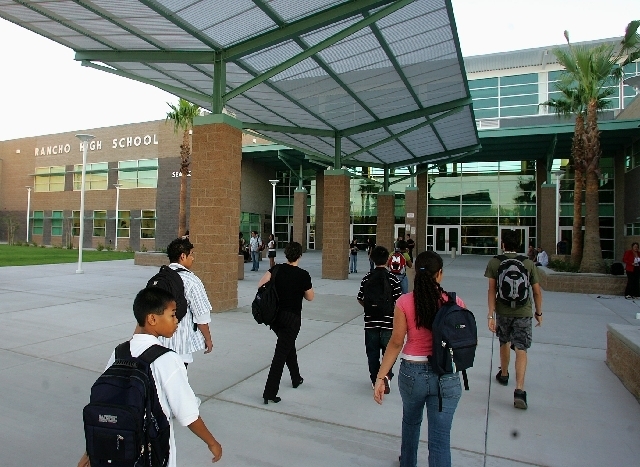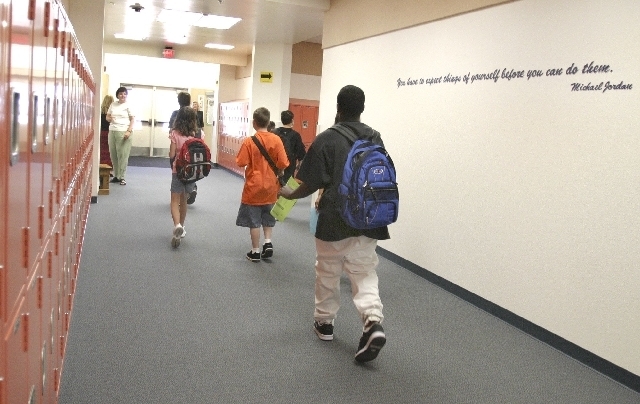Classes can be a big load for students, especially on their backs
Sixteen-year-old Aleza Sheppard is sure it’s going to happen.
For the sake of her aching back, however, she wishes the shift from textbooks to tablets and similar mobile devices –– already accomplished in an Austin, Texas, school district and mandated for Florida K-12 schoolchildren beginning in 2015-16 –– would happen sooner rather than later in Las Vegas.
“I end up soaking in a hot bathtub and taking pain relievers quite a bit during the school year because my backpack gets too heavy,” the Eldorado High School junior said. “It’ll be a lot lighter to just carry an iPad that I’ll be able to read my textbooks and library books on.”
Make no mistake: When arguments are made for mobile device technology and digital textbooks becoming the future of education –– often couched in terms of less expensive, easier to update interactive instruction materials that come alive through videos and audio –– students also want decision makers to remember that a backpack filled to the zipper with heavy textbooks can be a back breaker.
That they feel that way, according to doctors, shouldn’t be seen as whining.
For example, a study done in 2003 found that overloaded backpacks were the cause of more than 21,000 injuries treated at hospital emergency rooms, doctor’s offices and clinics, according to the U.S. Consumer Product Safety Commission.
Injuries ranged from contusions, strains and sprains to fractures of the back and shoulder.
Dr. Jay Fisher, head of pediatric emergency services at University Medical Center, said doctors there see a few sprains and strains each year.
“Fortunately, we haven’t seen anything too serious,” he said, with suggested treatment handed out by doctors much like the hot baths and pain relievers Sheppard and her 9-year-old sister, Sincere Dodd, a fourth-grader at Stanford Elementary School, already receive from their grandmother, Janice Bullocks.
“Sometimes they have to carry too much,” Bullocks said.
Jhone Ebert, chief innovation and productivity officer for the Clark County School District, noted that at a School Board meeting where a student talked in glowing terms about a pilot program at a school where iPads were used, the student not only praised the easy access to the curriculum 24 hours a day but expressed relief in not carrying a heavy backpack around.
“It’s definitely on the minds of students,” Ebert said.
Students across the nation expect their backpacks to be much lighter in the near future.
In a survey conducted last year by the respected Pearson Foundation, 69 percent of high school students said they expected the switch from textbooks to tablets to be carried out in the next five years.
Mike Barton, chief student achievement officer for the Clark County School District, said he expects the switch to happen locally, but lack of funding to buy devices for children makes it unlikely that the change will come within five years.
Given that reality, it makes sense to listen to what physicians and physical therapists suggest to parents to make present-day backpacks easier for their children to handle:
■ Purchase a backpack with wide, padded shoulder straps to prevent the straps from digging into the shoulder.
■ Make sure your child uses both shoulder straps, firmly tightened. If a child uses one strap, the weight is distributed unevenly, leading to lower back pain and muscle spasms.
■ Encourage that a hip strap be used when a child is carrying heavy loads to distributed the weight evenly between the back and hips.
■ Remind children to bend at the knees and use the legs when picking up a backpack.
■ Remember that safe backpack weight is 10 percent to 15 percent of a child’s total body weight. In other words, if a child weighs 75 pounds, his backpack should be about 8 to 11 pounds total. Some studies have shown children carrying more than a third of their total body weight on their backs.
Though alternatives to backpacks, including messenger bags, satchels and laptop bags have gained some popularity, the backpacks that almost every student now carries to school are still seen as the safest and most effective and efficient means to carry books, school supplies and other items because they distribute the weight most evenly.
Another alternative, and one used by students at some schools, are bags with wheels similar to the wheeled luggage airplane passengers pull behind them.
At first blush, that would appear to be the best carrier for students. But many educators say that the wheeled packs become dangerous in crowded conditions, with students tripping over the bags in hallways and on stairs.
“They tell us at my school that we can’t use them because they’re too dangerous,” Sheppard said.
The Clark County School District does not have a districtwide policy on the wheeled devices and parents who may want to have their children use them should find out what the individual school’s policy is, according to Melinda Malone, a spokeswoman for the district.
Parent-teacher associations across the country have noted that what can help lighten the load in student backpacks is better organization.
By using folders for individual subjects, for example, a child can bring home just the work he needs for the day as opposed to lugging everything home.
Trips to lockers between classes to unload books is also helpful.
The use of lockers, said Sheppard, “would be great.”
“But we can’t use them,” she said. “The school’s worried about some students putting drugs and guns in there, so we have to carry around our books and gym equipment and hygienic products all day. It’s a shame that a few kids can ruin it for everybody else.”
Contact reporter Paul Harasim at pharasim@ reviewjournal.com or 702-387-2908.
Balancing the load Backpack tips from health professionals to avoid muscle pain and posture problems. ■ Purchase a backpack with well-padded shoulder straps. Adjust straps so the pack fits snugly against the childs back. A pack hanging loosely from the back strains muscles. ■ A pack with a waist belt can help distribute the weight of the pack evenly. ■ A pack on wheels is easy on the back, but some schools dont allow them because they can be a hazard on stairways and hallways. Check school rules. ■ A loaded backpack should be no more than 10 to 15 percent of a childs body weight, according to the American Academy of Pediatrics. So a child weighing 100 pounds shouldnt carry more than 15 pounds. ■ To decrease chances of neck and shoulder pain, the pack should be carried with straps over each shoulder. Heavier items, such as books, should be placed at the bottom and other materials should be arranged so they dont slide around. ■ Leave unnecessary items at home or at school to lighten loads. ■ Teaching your child to bend at the knees when putting on a backpack will decrease chances of back pain. LAS VEGAS Review-Journal


















